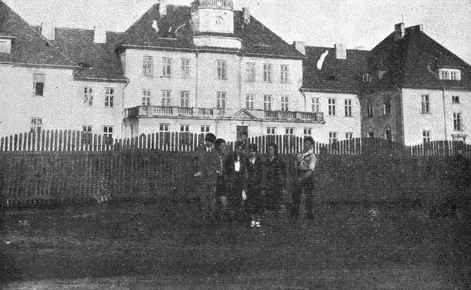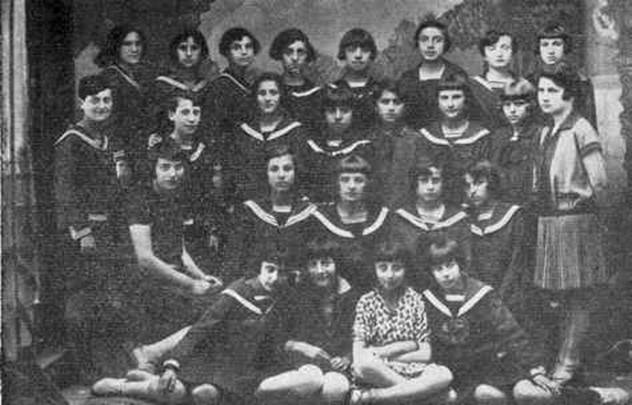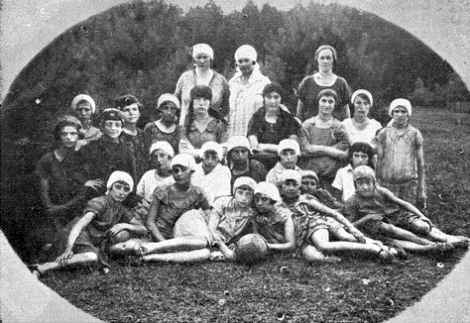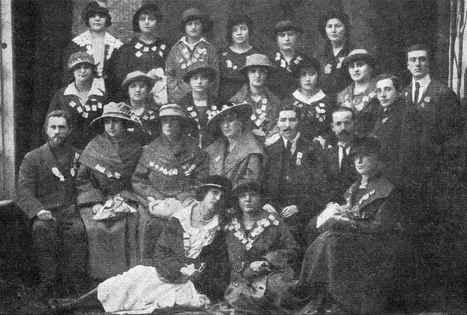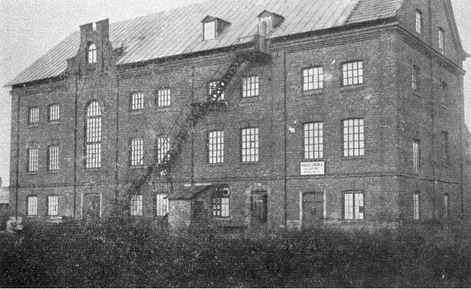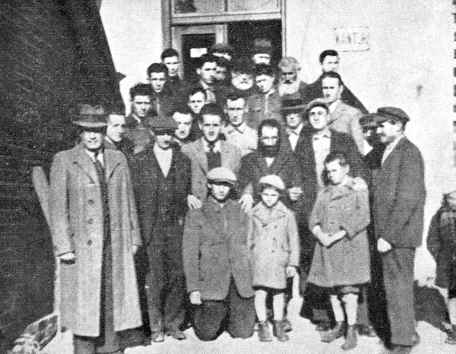Ostrów Mazowiecka
The Government Public School
By F. Epsztejn-Fresberg, New York
Translated by Judie Ostroff Goldstein
Ostrowa had three public schools between the two world wars – one for Jews and the other two for Christians.
Jewish teachers worked in the Public School for Jewish children. There were also two gymnasia – one for boys and one for girls. Before the First World War, no Jewish children were allowed to enroll in these schools. When Poland became independent, three Jewish girls were attending the gymnasia. I was one of the three first allowed to attend the school. We had to sit on a separate bench. Anti-Semitism still ruled. Professor Topolińksi, while telling about his life, said that once while looking for a building for the gymnasia, he found the perfect building, in a good location. But on looking around, he noticed the Jews in the area, so he did not rent the house for the gymnasia…we three looked at each other and our hearts were pounding from fear.
|
|
The Polish Gymnasia |
From the beginning, we were told (according to the Constitution of 3rd May) that we were free. That meant no writing on Shabes. But that promise was kept only for several weeks. After that, we were told there would be an Algebra class, which involved writing on Shabes. We went to the mathematics professor and explained we could not write, as it was our Sabbath.
This is only one case among the many anti-Semitic problems. A second case: a Polish lawyer (Arnold) lived in our courtyard. He had a married daughter in Warszawa and during vacations when his grandson came to Ostrowa, we were afraid to leave the house, because the boy beat us and screamed ugly remarks at us.
The school was a little outside the centre of town and consisted of two buildings next to each other. The teachers played with the children in the courtyard. The first year (1922-23) I worked in Zaręby Kościelne with Izrael Sztejnberg, the teacher. From 1923 until 1929 I was a teacher in the Ostrów Public School. It was called “District School No. 3”. The conditions were terrible – small classrooms and not enough teachers for the large number of children.
|
|
A public school class 1929 |
|
|
The summer camp in 1929 |
In 1923 I had a class of sixty-six children. At the end of each school year all the teachers took their classes to Goldsztejn, the photographer. In 1929 it was my job to organize a summer camp for poor children. With Mosze Raf's approval, I got down to work and organized a ballet presentation with twelve children from my class to raise money for the camp. I made paper costumes for the children. Two other teachers – Zosia Fabian (a fiddler) and Edek Frankfurtski (a pianist) helped choreograph the ballet. The children rehearsed at the Kagans. I arranged to use the theatre at no charge and the performance was well received. The Nutkiewicz's who owned the sawmill and the Lichtensztejns both made donations and sent their children to the camp as well. Other wealthy families donated food.
With the help of my mother, the social worker and my sister Ester, who handled the bookkeeping, the summer camp became a reality. In order to stay within budget, we had to take a few children from wealthy families, because of the large number of children who would be paying nothing.
There were about thirty children and two hired cooks. We had a wonderful summer: six weeks of fresh air, physical and mental activities and good food. When I think about that time, I remember the sunny days in Zambrower forest – in Ostrowa.
Linas Hazedek
By Synai Kac, Haifa
Translated by Judie Ostroff Goldstein
One of the oldest and most important institutions in Ostrowa was Linas Hazedek. The word linas (overnight) explains the importance of those who agreed, after a long, hard day of work, to stay overnight or more correctly, keep watch over the sick, to relieve the other members of the household who were tired and could no longer cope.
The majority of towns and villages in Poland did not have hospitals. In the cities, there were state or government hospitals, but the Jews, especially religious ones, for various reasons did not want to or did not know to go to them.
|
|
A fund-raising day on behalf of Linas Hazedek |
The exception was the Jewish hospital on ulica Czesta in Warszawa. It had good doctors and devoted nurses and provided good care. Therefore it was always full and it was difficult to get admitted, especially from a provincial town. Therefore the sick remained at home in poor, crowded conditions, becoming a burden to family members who were tired and did not know how to care for the sick.
That is why the Linas Hazedek society was such an important and popular institution in town. They cared for the sick; rich and poor alike. They brought a doctor and medicine for the poor, who were the majority.
It is clear the work demanded a lot of volunteers and helpers and they were recruited from among “ordinary” Jews. Only the full-time secretary was paid a wage.
Today it is difficult to explain to the younger generation what this society represented. They do not understand the devotion and self-sacrifice of these people, especially the small merchants, artisans and workers who, after a long hard day of work, voluntarily watched over a sick person the entire night.
I would like to mention several of the volunteers who were exceptionally devoted to Linas Hazedek.
The first is Reb Efrim Rybka, called “Froim der Hitlmakher” [the hat maker], a simple Jew with a good heart. He worked hard to feed his large family. During his free evenings, he made hats and during the day travelled to the markets and fairs to sell them. He returned tired from the road, ate quickly and went to Linas Hazedek to find out what had happened during the day and if somebody needed his help. He gave a lot of time to Linas Hazedek. He knew about all the troubles in town, would help or send somebody else to help, would stay overnight with the sick and find others to the same, would inquire about gravely ill people, gave advice and also drove patients to the hospital in Warszawa when necessary.
The following are some interesting episodes.
While Margolis was a member of the town council, Reb Efrim Rybka once woke him in the middle of the night to accompany him to the council President to procure the necessary permit to drive a very sick person to Warszawa for an operation. They went together to the President and after getting the necessary document he then drove the sick person to Warszawa and saved this person's life.
The second is about Reb Lejbl Olszaker who also dedicated his life to Linas Hazedek until he became ill with a heart condition and had to give up his activities. He was the “warehouse cashier” for Linas Hazedek and kept a rigorous watch over the items that were given out, such as medicine and sanitary articles.
And to end, several words about the devotion of the chairman of the society, Reb Mordchai Kohn, who lead the institution from the time he returned from Russia in 1922 until he left for Israel in 1937.
He was out of town the entire week, returning Friday mornings and leaving again on Monday morning. He devoted those two days to Linas Hazedek and was its driving force. Without his confirmation nothing could be done. He died in Israel the 25th of Tishre 5717 [September 1957].
May all the volunteers be remembered and blessed forever.
Khakhnasas Orhim
By Mosze Icchok Tofel, New York
Translated by Judie Ostroff Goldstein
Among the numerous institutions in Ostrowa that dealt with charitable works, such as Talmud Torah, Linas Hazedek and Khakhnasas Kalah, there was also a society called Khakhnasas Orhim. It is not known when it was founded, but I remember it being in existence in 1895 and it was still ongoing when I left Ostrowa for America in 1920.
The aim of this noble institution was to insure that poor people from other towns and villages would have a place to stay while in Ostrowa for a couple of nights and take care of their needs. Without this society, every stranger would have had to go house to house to find a place to stay and in those times there were not many rich people.
The gabeh or shamas from Khahnasas Orhim provided small change and later stamped coupons from the society. These coupons were accepted by all Ostrowers and were worth a half groshen. The needy were given a place to sleep in the Khahnasas Orhim and there was a shamas there to keep order.
The name of the gabeh at that time was Reb Hirsz Mordchai, the mason (made ovens and chimneys to bake and cook, his work was known by everyone). The previous shamasim were: the first, Reb Jankiel Nacher, the second, Reb Bejnisz Beczka (a devoted melamed, who never had a beard – through a quirk of nature) and the third, Reb Abraham Markus.
The funds for the society came from membership dues as well as from a collections made every Friday by the shamas who went to every Jewish house to collect a kopek, [penny] two or maybe even three.
This society (like all other societies) required its officers to have certain clothing that generally included a sword. They would wear these clothes to each simcha in town. Wearing these clothes and masks, nobody would know who they were and so they went to simchas to collect alms. Also at Purim they would go through town and collect more alms.
Today we stand with bowed heads, broken hearts and in grief for our hometown with its dear, beloved and respected Jews who were murdered by the Nazis.
Also, to all Ostrower Jews throughout the entire world and especially in Israel, be strong and courageous.
“Gmiles Khesed” Fund
By Synai Kac, Haifa
Translated by Judie Ostroff Goldstein
“There are three things that people need: “Torah, work and a free loan institution.” The last mitzvah nearly every Jew realized: in every town and village in Poland there was a gmiles khesed [free loan fund]. In 1928 a fund was created in Ostrowa initiated by the famous Reb Michel son of Iser Tejtel.
The economic situation for Jews then was very difficult. The artisans were not able to buy raw material and the small merchants did not have enough money to buy more merchandise.
There were two banks in town: one for artisans and the second for merchants, but at that time nobody could afford to pay their high rates of interest. It was decided to create a free loan institution to help the needy with loans, to be paid back in small installments without interest.
There were a few pessimists who did not believe in the fund, because in those terrible times creating the fund was a bold undertaking and for some – a dream. They did not believe that anybody had the necessary money.
But thanks to the stubbornness, energy and devotion of a great Jew, Reb Michel Tejtel, the institution was able to stand on its own two feet.
He divided the town into districts and convinced volunteers to go to all the homes and get donations to enable the founding of the institution and to start its activities.
Despite his poor health Reb Michel did not sit at home. He went out to find wealthy men in town and without exception, they all gave a fine donation.
The fund began working on the 19th of December 1928 and the financial report, for the first year (1929) showed 988 loans to 346 borrowers for a sum of 66,846 Polish Zlotys [in the late 1930's a zloty was worth about 20 cents].
The loans were paid back monthly with a minimal surcharge to cover operating costs.
The borrowers knew that they were responsible for the entire loan and their records had to show that they were capable of repaying the sum borrowed. Their very existence depended on them repaying the loans, especially since the two banks were bankrupt and could not pay back the shareholders and could not give out any new loans.
A committee to direct the fund was chosen during a meeting at the beginning of 1929 and consisted of: the founder of the fund Reb Michel Tejtel – Chairman; Aron Jasiński – Vice-chairman; Jona Austriak, Treasurer; Chaim Estryk, committee member and Lejbl Margolis, honourary and recording secretary. Szmuel Ryba was the technical secretary and he worked with heart and soul until the war broke out.
Also, the former vice-mayor Izrael Zlotkes helped found and strengthen the fund and remained interested in the institution all through its existence.
In order to increase the fund, the free loan institute created a “Golden Book” in the winter of 1929-30. They held a grandiose meeting with the purpose of selling pages in the book in which the names of the donors would be written.
After the death of the founder Reb Michel Tejtel z”l, Aron Jasiński became president. He led the institution with dignity and devotion. In June 1932, a new committee was elected: President – Aron Jasiński; Vice-President – Mordchai Kohn; Treasurer – Jona Austriak; Members: Chaim Estryk, Mosze Rozencwejg, Jozef Prawda, Aron Frejlich, and Abraham Wagman. The oversight committee: Dawid Lichtensztejn, Icchok Morgensztern and Chaim Icchok Glynka, now living in Israel.
The importance of this agency was made evident during the meeting in 1932. The financial statement for three and a half years was presented showing that during that time (from December 19, 1928 through June 1, 1932) 3,670 loans were approved for a total of 287,000 Zlotys to 250 merchants, 230 artisans and 150 others, such as butchers, porters and wagon drivers.
The meeting in 1934, shortly before I left for Israel, made an impression on me because of the numerous participants who were interested in the institution and in helping one another. The memory of all those who died or were murdered during the great catastrophe, will always remain dear and holy for us.
May their souls be bound up in the bonds of life.
The Banks in Town
By Arija (Leib) Margolis
Translated by Judie Ostroff Goldstein
A city with a developing commerce, connected to other larger and smaller cities, as was our town, needs credit institutions.
In times past, financial matters and other operations were accomplished through the mail or a broker in the large cities. Those who needed loans had to find brokers or private individuals and were charged high interest rates.
The Folks Kaseh [People's Fund], was based on mutual help and whoever needed it could become a member and pay ten percent interest on the sum borrowed. The loan was repaid in weekly installments. The loan was secured with a promissory note and guarantors. The fund was backed by the “Yaiko” institution that had invested money to increase available capital.
This type of fund was also created in Ostrowa and Dr. Rubin Klaczka was in charge.
During the First World War in 1914, there was a moratorium on loans as the large merchants and businessmen were exiled to Russia. Those who remained in Ostrowa were poverty stricken. It was impossible for the fund to continue and it was liquidated.
In 1924, when commerce had stabilized a little, the merchants realized they needed to open a similar institution and the Merchant Bank was founded under the name Bank Spóldzielczy [Cooperative Bank].
The bank prospered and the name was changed to “Bank Kupcow i Przemisłowców” [Merchant and Industrial Bank] and also included the Zionist Bank. Mosze Gutmer was the director.
Not long afterwards an artisan bank was also founded. With time the bank grew and became involved with various businesses in town and eventually evolved into an Agudas Yisroel institution. The director was Icchok Brzoza.
This lasted until 1929-30 when the economic situation was bleak and many businessmen found themselves in terrible circumstances and the merchants were unable to keep their businesses going. Also the large mill “Automat”, that provided a living for many hundreds of families, had a business relationship with the banks, stopped making payments and this had an effect on both financial institutions in town, undermining their existence, prestige and the confidence of the population.
After several years of struggling under difficult conditions, the banks had to liquidate.
The Mill “Automoat” of Kagan and Partners
By Chaim Glynka
Translated by Judie Ostroff Goldstein
The city's local colour would not be complete if we did not write about the largest enterprise in the city. The Mill “Automat” which was one of the largest mills in Poland and was famous for its fine quality flour - the best in all of Poland.
The mill fed - directly and indirectly - several hundred families, dealers selling wheat for the mill and buyers of flour and bran. It also employed ten specialists, workers, foremen, porters, etc.
The number of Jews in the city grew with the enterprise, which was famous throughout Poland and always worked to improve its products. The products reached every corner of Poland and had a good reputation.
The owners: Kagan, the Trejster brothers, and Bandrymer were national supporters and gave with a generous hand to the institutions in the city, also to national funds such as Keren Kayemet and Keren HaYesod.
|
|
The Mill “Automat” |
|
|
A group of brewery workers with Icchok Tejtel (first on the left) |
The Brewery in Ostrow
From Mrs. Chana'cze Tejtel in Israel
Translated by Judie Ostroff Goldstein
The brewery was founded at the end of the nineteenth century by the merchant and entrepreneur Reb Zev Tejtel, from one of the branches of the Tejtel family in the city. He died in 1910 at the age of seventy-five.
Afterwards his sons Michal, Berel, Hesel and sons-in-law Iser Welczer and Chaim Jakob Zwikelski inherited the brewery.
Icchok Tejtel, Michal and Fejga Tejtel's son was in charge of the technical work (the brewing). He had completed vocational training in Germany where he studied under the best brew masters. Thanks to him the beer was of the highest quality and was known throughout the region, even in Warszawa.
Fifty people worked at the brewery, two-thirds of them Jews. The relationship between the bosses and the workers was exemplary. There was never a strike at the brewery. The bosses set the wages according to the selling price and the workers received benefits and various privileges.
This was also due to the leader of the Bund in the city, Eliachu Kosower (a religious Jew, who went every day to pray and say Psalms). He had a lot of influence with the workers.
